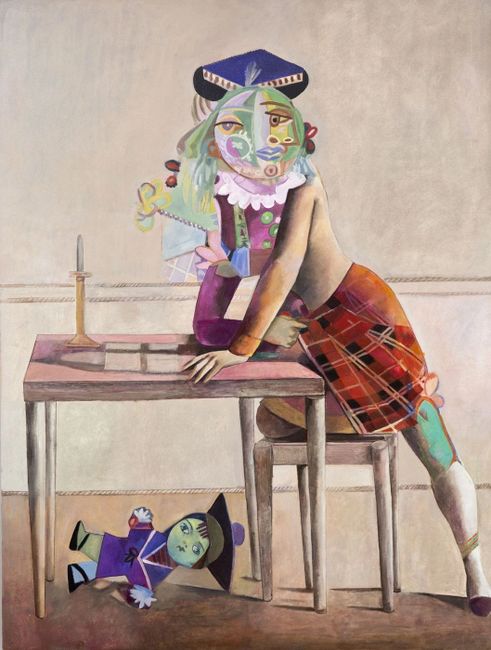
Maya
Wolfe von Lenkiewicz, Maya, 2009
The original was created using oil on canvas.
I interpret information that is given to me via museums, I don’t see the works of art in the galleries from other eras as anything but material, which I can use. I do not try to pretend that I have access to their true meanings, nor do I think it’s possible in totality to understand their views. In effect, they come to me as a fiction created by society, which I myself unweave and reorganize.
~Wolfe von Lenkiewicz
Wolfe von Lenkiewicz is a British artist who studied Philosophy and Epistemology (the theory of knowledge) at York University. He comes from a long line of established painters, including his father Robert Lenkiewicz and great-grandfather Baron von Schlossberg who acted as court painter to King Ludwig II of Bavaria. His post-modern melding of styles, iconography, and narratives draw on both figurative and decorative painting as a critical tool in examining the history of images in the western world.
Lenkiewicz experiments in what he refers to as a re-sequencing process by which he turns the established perceptions of art history upside down. By intertwining and revising well-known masterpieces by artists like Vermeer, Caravaggio, Matisse, Picasso and Koons to name a few, Lenkiewicz provides a new perspective and a contemporary interpretation that allows viewers to derive fresh meaning. His work challenges the notion of authorship and explores the ongoing possibilities of image manipulation. It also suggests that an artwork is never truly complete, just an iteration of many things to come.
The highly intelligent Lenkiewicz’s fascination with the appropriation is demonstrated in his bold experiments with iconography and pictorial combinations which bring together the traditional and contemporary. One such example is his painting, Maya. Here Lenkiewicz blends the visual imagery of Picasso’s portrait style with the subject matter of Balthus’ painting, Solitaire* of 1955. Picasso’s late Cubism style is found in Maya’s fractured, Cubist face as well as unnatural minty green skin tone she shares with the Picasso-style doll beneath the table. The scene is a direct reference to Balthus’ painting, with the only changes being to the leaning girl’s now Cubist appearance and the inclusion of a doll that takes the place of Balthus’ playful black and white cat. By making these changes, Lenkiewiczinvites the viewer to look at the history of art with fresh eyes across time, cultures, countries and ideologies.
Defying convention, Lenkiewicz reimagines paintings to create a new visual language, one that is malleable. And in the artist’s words, “It’s really just an infinite play of language with no end.” Lenkiewicz’ artistic practice requires that we think about visual culture today, raising questions about how our understanding of the past and the present are forever in flux.
At the onset of the world’s shelter in place orders, people from across the word have been reimagining themselves into famous artworks. Since we currently cannot visit museums or galleries, why not make the masterpiece your self? Museums worldwide challenged art lovers to post photos of themselves recreating their favorite artworks from home and the response has been incredible! From cats dressed as Vermeer’s Girl with a Pearl Earring to family members recreating Botticelli’s Birth of Venus the trend shows no signs of slowing down. Simply choose an artwork that inspires you, and using items found around your home, have a go at making yourself a piece of art history! We’d love to see your masterpiece! Please share your recreations with us and we may post them on our website: emergencyartmuseum@gmail.com
https://mymodernmet.com/recreate-art-history-challenge/
https://mymodernmet.com/izoizolyacia-isolation-art-challenge/
*analytical cubism – (1908-12) Dominated the first four years of the Cubist movement. It is characterized by monochromatic, topsy-turvy canvases full of overlapping, geometric forms. The arrangement of these fragments form the subject, which is often unrealistically depicted from multiple angles at once.
*cubism – An artistic style that features subject matter broken down into fractured forms as if you are looking at an object or figures from multiple viewpoints at once. Pioneered by both Picasso and Georges Braque and renowned as one of the most important art movements, Cubism is separated into two primary phases: Analytical and Synthetic.
*iconography – The visual images and symbols used in a work of art or the study or interpretation of these. As a branch of art history, iconography studies the identification, description, and the interpretation of the content of images: the subjects depicted, the particular compositions and details used to do so, and other elements that are distinct from artistic style.
*synthetic cubism – Unlike Analytical Cubist works, paintings rendered in the Synthetic Cubist style were simplified, polychromatic, and inspired by collage art. Like the former phase of the movement, however, these paintings convey an interest in abstraction.
Wolfe von Lenkiewicz
For more information on the artist, visit https://wolfevonlenkiewicz.com/
Copyright © 2020 Emergency Art Museum - All Rights Reserved.
*The Emergency Art Museum claims no ownership, or copyright to any materials found here, or on-site. The Emergency Art Museum functions solely as a non-commercial, non-profit, educational resource for the community. All artwork represented or reproduced, has been done so for educational purposes only under the fair use act.
-Johnny DePalma, Owner / Curator
-Janelle Graves, Art Historian / Museum Educator